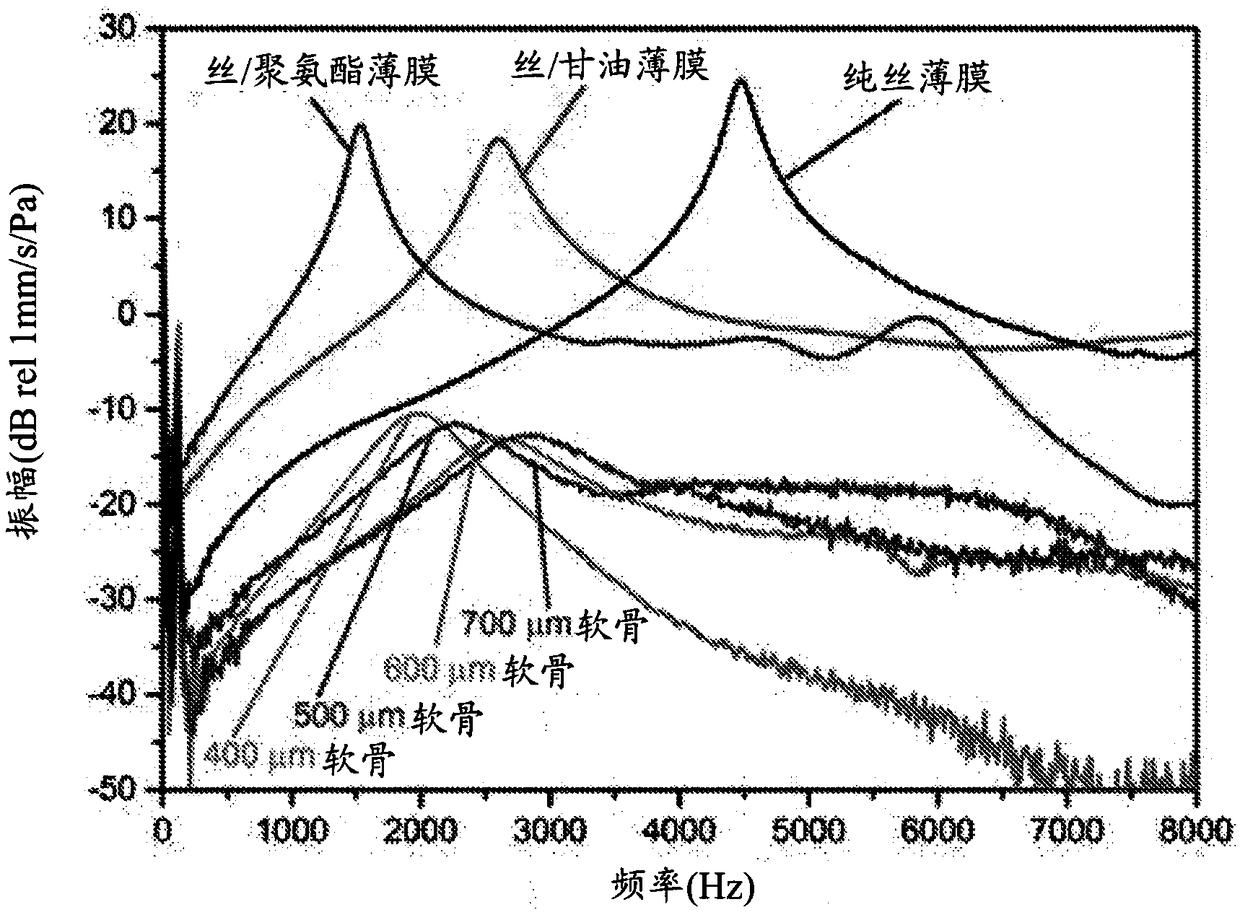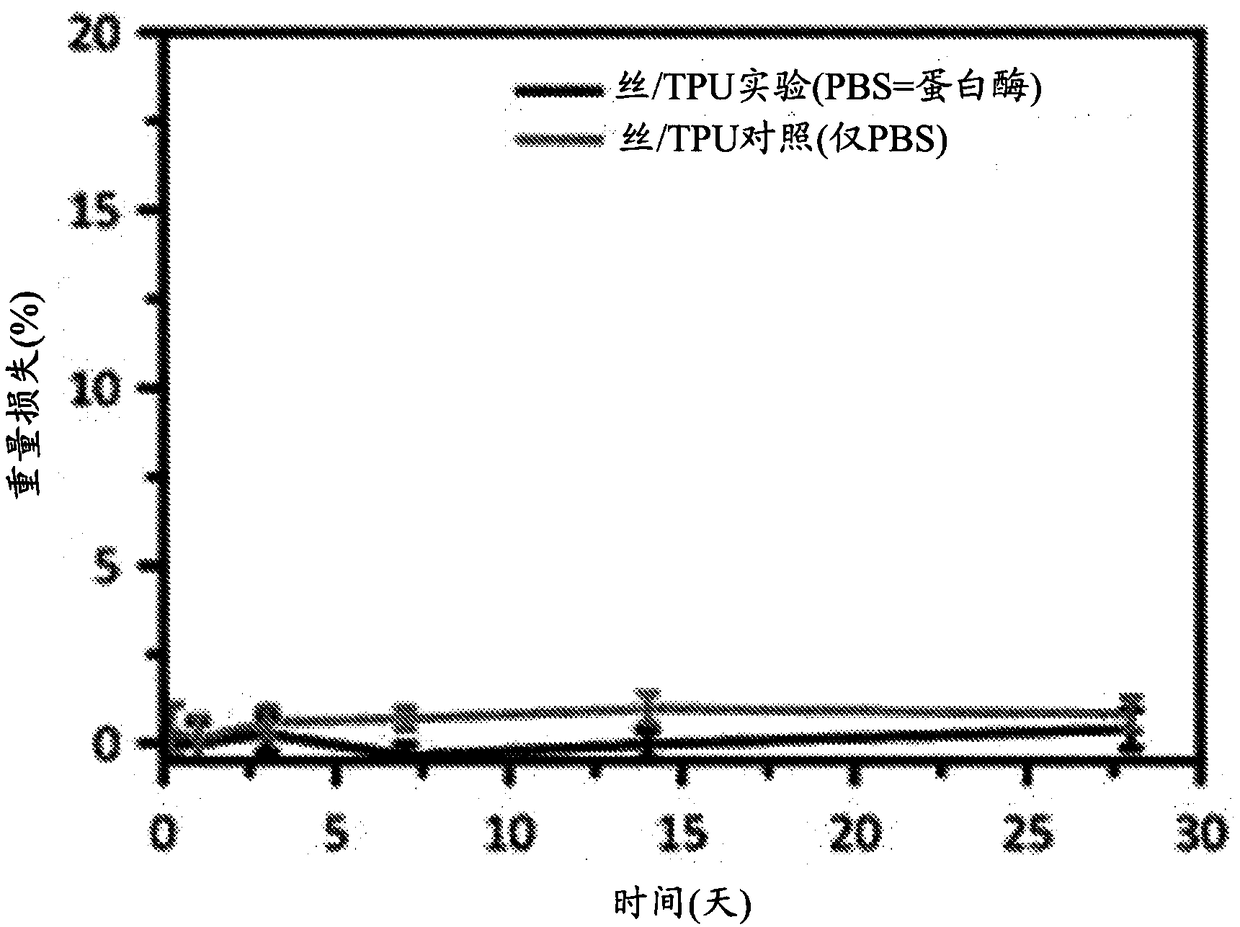Improved silk fibroin biocompatible polyurethane membranes
A biocompatible, silk fibroin technology, applied in fiber treatment, tissue regeneration, ear implants, etc., can solve problems affecting mechanical properties and achieve enhanced solubility and durability
- Summary
- Abstract
- Description
- Claims
- Application Information
AI Technical Summary
Problems solved by technology
Method used
Image
Examples
Embodiment approach
[0068] The silk fibroin membrane matrix prepared according to the present invention is biodegradable, biocompatible, and compared with most other natural and synthetic biomaterials (such as collagen and polylactic acid (PLA)) in its mechanical strength, One or more of elongation and stiffness are improved.
[0069] a. silk fibroin membrane matrix
[0070] The invention provides a silk fibroin biocompatible polyurethane film matrix. The film matrix of the present invention exhibits higher extensibility than silk films lacking biocompatible polyurethane.
[0071] The membranes of the present invention are made for the repair of perforated tympanic membranes, especially chronic perforations. Additionally or alternatively, the membranes of the present invention may be fabricated for the repair of a subject's ear canal, particularly the flaccidity and / or scutum. Preferably, the membrane is fabricated for delivery of a device particularly suited for repairing the eardrum.
[0...
Embodiment 1
[0257] The preparation of embodiment 1-silk foam
[0258] Undegummed fibers from the polymorphic silkworm (Bombyx mori) on reels were purchased from a production center in northeastern India. Fibers were degummed using 2 g / L sodium carbonate (Sigma-Aldrich, St. Louis, MO, USA) and 1 g / L odorless castile soap (Vasse Virgin, Wilyabrup, Western Australia, Australia) at 98°C for 30 min. Degumming was performed using a rotary staining machine (Ahiba IR Pro, Datacolor, Lawrenceville, USA). The degummed fibers were dried overnight at 40 °C and then dissolved with 9.3 M LiBr at 60 °C for 5 h. With deionized water (dH 2 O) The dissolved silk solution was dialyzed at 4°C for 3 days to obtain an aqueous silk solution with a concentration between 4 and 5% w / v as calculated by gravimetric analysis. The silk solution from each batch was diluted to 4% w / v and then pipetted into tubes, 20 mL in each tube. The solution was frozen in a -80 °C freezer for 24 h. The frozen tubes were removed...
Embodiment 2
[0259] The preparation of the silk fibroin / polyurethane film of embodiment 2-blending
[0260] Freeze-dried silk foam was chopped into small pieces with a scalpel and added to sterile centrifuge tubes along with polyurethane pellets. Then, both materials were dissolved in 1,1,1,3,3,3-hexafluoro-2-propanol (HFIP) for 5 hours at room temperature on a rotary mixer. The amounts of silk, polyurethane and HFIP used were calculated such that the final concentration of the two materials was 5% (w / v) polyurethane and 1.25% (w / v) silk fibroin (or 1:4 silk:polyurethane). The dissolved samples were centrifuged at 7000 xg for 2 min to remove air bubbles, then cast into 55 mm diameter petri dishes and allowed to dry in a fume hood for 24 h. All films had a final thickness of 100 μm.
PUM
| Property | Measurement | Unit |
|---|---|---|
| tensile strength | aaaaa | aaaaa |
| tensile strength | aaaaa | aaaaa |
| tensile strength | aaaaa | aaaaa |
Abstract
Description
Claims
Application Information
 Login to View More
Login to View More - R&D
- Intellectual Property
- Life Sciences
- Materials
- Tech Scout
- Unparalleled Data Quality
- Higher Quality Content
- 60% Fewer Hallucinations
Browse by: Latest US Patents, China's latest patents, Technical Efficacy Thesaurus, Application Domain, Technology Topic, Popular Technical Reports.
© 2025 PatSnap. All rights reserved.Legal|Privacy policy|Modern Slavery Act Transparency Statement|Sitemap|About US| Contact US: help@patsnap.com



